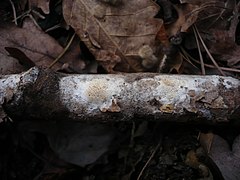Ceriporiopsis
| Ceriporiopsis | |
|---|---|

| |
| Ceriporiopsis gilvescens | |
| Scientific classification | |
| Kingdom: | Fungi
|
| Division: | |
| Class: | |
| Order: | |
| Family: | |
| Genus: | Ceriporiopsis (1963)
|
| Type species | |
| Ceriporiopsis gilvescens (Bres.) Domański(1963)
| |
| Synonyms[3] | |
Ceriporiopsis is a genus of fungi in the family Phanerochaetaceae. The genus is widely distributed, and, according to a 2008 estimate, contains about 25 species.[4] Ceriporiopsis was circumscribed in 1963 by Polish mycologist Stanislaw Domanski.[5] The genus is a wastebasket taxon, containing "species that share common macroscopic and microscopic characteristics, but are not necessarily related."[6] Ceriporiopsis species are crust fungi that cause a white rot. They have a monomitic hyphal system, containing only generative hyphae, and these hyphae have clamp connections.
Species[]
- C.L.Zhao, B.K.Cui & Y.C.Dai (2014) – China[7]
- Núñez, Parmasto & Ryvarden (2001)
- Ryvarden (2016) – Colombia
- (Corner) T.Hatt. (2002)
- Niemelä (1985)
- (D.V.Baxter) Gilb. & Ryvarden (1985)
- (Bres.) Ryvarden (1988)
- Ryvarden, Gomes-Silva & Gibertoni (2016) – Brazil
- (Bres.) Ryvarden (1988)
- (G.Cunn.) P.K.Buchanan & Ryvarden (1988)
- M.Mata & Ryvarden (2010)
- (Parmasto) Ryvarden (1986)
- (Corner) T.Hatt. (2002)
- Log.-Leite, G.V.C.Gonç. & Ryvarden (2001)
- Ryvarden (2016) – Mexico
- C.J.Yu & Y.C.Dai (2007)
- C.L.Zhao & Y.C.Dai (2015)
- (Murrill) Ryvarden (1985)
- (Bres.) Domański (1963)
- Bernicchia & Ryvarden (2003)
- Fortey & Ryvarden (2007)
- Ryvarden & Iturr. (2004)
- (Berk. ex Cooke) Ryvarden (2015)
- Ryvarden (2016) – Venezuela
- Ceriporiopsis jelicii (Tortič & A.David) Ryvarden & Gilb. (1993)
- Læssøe & Ryvarden (2010)
- Ceriporiopsis kunmingensis C.L.Zhao (2016)[8] – China
- Læssøe & Ryvarden (2010) – Ecuador, China[9]
- B.K.Cui (2013)[10]
- Rajchenb. (1987)
- (Berk.) Rajchenb. (2003)
- T.T.Chang & W.N.Chou (1999)
- (Pers.) Gilb. & Ryvarden (1985)
- Leif Ryvarden (2016) – Namibia
- Ryvarden (2001)
- Ryvarden (2000)
- (A.David) Ryvarden & Gilb. (1993)
- Ceriporiopsis pseudoplacenta Vlasák & Ryvarden (2012)[11]
- (Romell) Domański (1963)
- C.L.Zhao & Y.C.Dai (2015)
- C.L.Zhao, B.K.Cui & Y.C.Dai (2014) – China[7]
- (A.David) M.Pieri & B.Rivoire (1996)
- (Pilát) Gilb. & Ryvarden (1985)
- (Murrill) Ryvarden (1985)
- Ryvarden (2004)
References[]
- ^ Jülich, W. (1982). "Notes on some Basidiomycetes (Aphyllophorales and Heterobasidiomycetes)". Persoonia. 11 (4): 421–8.
- ^ Vampola, P. (1992). "Pouzaroporia, gen. nov. – a new genus of the polypores". Ceská Mykologie. 46 (1–2): 57–61.
- ^ "Ceriporiopsis Domański". Species Fungorum. CAB International. Retrieved 2014-08-14.
- ^ Kirk, P.M.; Cannon, P.F.; Minter, D.W.; Stalpers, J.A. (2008). Dictionary of the Fungi (10th ed.). Wallingford, UK: CAB International. p. 128. ISBN 978-0-85199-826-8.
- ^ Domanski, S. (1963). "Dwa nowe rodzaje grzybów z grupy "Poria Pers. ex S.F. Gray"". Acta Societatis Botanicorum Poloniae (in Polish). 32 (4): 731–9. doi:10.5586/asbp.1963.044.
- ^ Miettinen, Otto; Larsson, Karl-Henrik (2011). "Sidera, a new genus in Hymenochaetales with poroid and hydroid species". Mycological Progress. 10 (2): 131–141. doi:10.1007/s11557-010-0682-5.
- ^ a b Zhao, C.L.; Cui, B.K. (2014). "Phylogeny and taxonomy of Ceriporiopsis (Polyporales) with descriptions of two new species from southern China". Phytotaxa. 164: 17–28. CiteSeerX 10.1.1.431.3933. doi:10.11646/phytotaxa.164.1.2.
- ^ Zhao, Chang-Lin; Wu, Zi-Qiang (2016). "Ceriporiopsis kunmingensis sp. nov. (Polyporales, Basidiomycota) evidenced by morphological characters and phylogenetic analysis". Mycological Progress. 16 (1): 93–100. doi:10.1007/s11557-016-1259-8.
- ^ Zhao, Chang-Lin; Liu, Shi-Liang; Ren, Guang-Juan; Ji, Xiao-Hong; He, Shuanghui (2017). "Three species of wood-decaying fungi in Polyporales new to China". Mycotaxon. 132 (1): 29–42. doi:10.5248/132.29.
- ^ Cui, Bao-Kai (2013). "Two new polypores (Ceriporiopsis lavendula and Skeletocutis inflata spp. nov.) from Guangdong Province, China". Nordic Journal of Botany. 31 (3): 326–330. doi:10.1111/j.1756-1051.2012.01674.x.
- ^ Vlasák, Josef; Vlasák, Josef Jr.; Ryvarden, Leif (2012). "Four new polypore species from the western United States". Mycotaxon. 119: 217–231. doi:10.5248/119.217.
Categories:
- Phanerochaetaceae
- Polyporales genera
- Taxa described in 1963
- Polyporales stubs